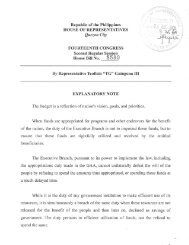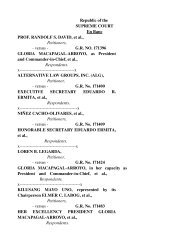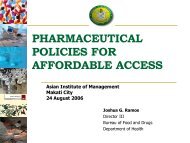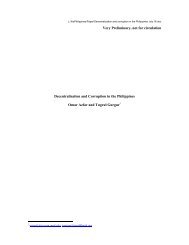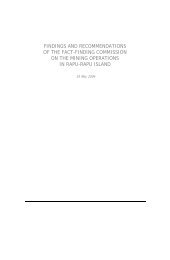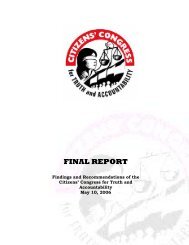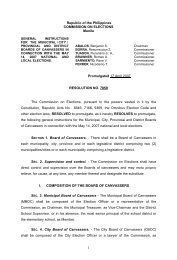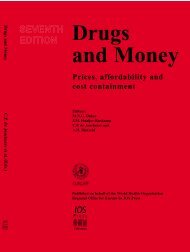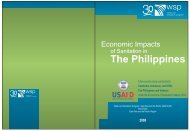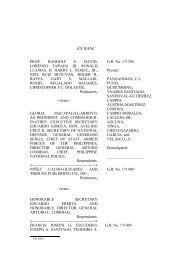i Report Issue No. 3 2005 - Philippine Center for Investigative ...
i Report Issue No. 3 2005 - Philippine Center for Investigative ...
i Report Issue No. 3 2005 - Philippine Center for Investigative ...
Create successful ePaper yourself
Turn your PDF publications into a flip-book with our unique Google optimized e-Paper software.
C A M P A I G N F U N D S<br />
Buying votes. In<br />
the 2004 elections,<br />
President Arroyo used<br />
government funds<br />
to win the loyalty of<br />
local officials and the<br />
affection of voters.<br />
NEY<br />
tion of free rice and fertilizers, the<br />
emergency employment of thousands<br />
of street sweepers, and the<br />
nationwide display of road signs<br />
bearing the president’s name.<br />
Today the public is being<br />
treated to the spectacle of witness<br />
after witness spewing out<br />
exposés about the president and<br />
her family using jueteng money<br />
to fund the election. In reality,<br />
the state funds used <strong>for</strong> Arroyo’s<br />
election campaign dwarf the alleged<br />
jueteng contributions. By<br />
our estimates, at least P5 billion<br />
could have been pooled from<br />
various government agencies to<br />
oil Arroyo’s campaign machinery.<br />
Farmers’ groups allege that even<br />
part of the confiscated Marcos<br />
wealth was used <strong>for</strong> projects to<br />
advance the president’s re-election.<br />
In comparison, the most<br />
sensational claims so far have<br />
been that jueteng lord Rodolfo<br />
‘Bong’ Pineda contributed P300<br />
million to the Arroyo campaign.<br />
It took years to lay the<br />
groundwork <strong>for</strong> mobilizing government<br />
resources <strong>for</strong> the president’s<br />
re-election. It entailed,<br />
first of all, the appointment of<br />
allies to government agencies<br />
with pots of funds that could<br />
be tapped <strong>for</strong> the campaign. It<br />
also entailed the identification<br />
of those funds and their release<br />
at the right time. Such strategic<br />
planning, in the words of Senator<br />
Sergio Osmeña III, “was so<br />
systematic, it’s mind boggling.”<br />
WHERE THE MONEY<br />
CAME FROM<br />
Most of the fund releases began<br />
in early February, just be<strong>for</strong>e the<br />
start of the 90-day campaign <strong>for</strong><br />
the presidency, and continued<br />
till April. But huge chunks of<br />
money were already released<br />
to local officials even in late<br />
2003. The amounts involved<br />
are huge, and they included the<br />
following:<br />
● On February 2, 2004, Labor<br />
Secretary Patricia Sto. Tomas,<br />
in her capacity as chairperson<br />
of the Overseas Workers’<br />
Welfare Administration<br />
(OWWA), along with then<br />
OWWA Administrator Virgilio<br />
Angelo signed a resolution<br />
transferring P530 million<br />
from the OWWA medicare<br />
fund to the <strong>Philippine</strong> Health<br />
Insurance Corporation. This<br />
amount was used to subsidize<br />
the Philhealth cards<br />
given away in places where<br />
Arroyo campaigned.<br />
● On February 3, 2004, Budget<br />
Secretary Emilia Boncodin<br />
signed a Special Allotment Release<br />
Order or SARO addressed<br />
to the Office of the Secretary of<br />
the Department of Agriculture<br />
(DA) <strong>for</strong> P728 million. The<br />
amount was “to cover the<br />
purchase of farm inputs,” and<br />
was classified as an additional<br />
program. The amount was distributed<br />
to mayors, governors,<br />
and congressmen.<br />
● On February 11, 2004, Boncodin<br />
signed another SARO<br />
<strong>for</strong> the DA, making available<br />
P1.1 billion “to cover the GMA<br />
Rice and Corn and Livestock<br />
Program.” Again, the amount<br />
was disbursed to mayors, governors,<br />
and congressmen.<br />
● On March 23, 2004, the Department<br />
of Budget and Management<br />
(DBM) released to<br />
the National Irrigation Authority<br />
(NIA) P541 million from the<br />
Marcos wealth supposedly <strong>for</strong><br />
activities in connection with<br />
the Comprehensive Agrarian<br />
Re<strong>for</strong>m Program. That fund,<br />
which was allegedly used <strong>for</strong><br />
the campaign, has yet to be<br />
accounted <strong>for</strong>.<br />
● On April 10, 2004, the<br />
president issued an executive<br />
order instructing that the<br />
poorest families be identified<br />
and that those with college-age<br />
children be given<br />
P10,000-vouchers each that<br />
they can use <strong>for</strong> technical or<br />
college education.<br />
● On April 28, 2004, the DBM<br />
also in<strong>for</strong>med the Department<br />
of Agrarian Re<strong>for</strong>m (DAR), of<br />
the release of P544 million<br />
“to cover funding requirements<br />
<strong>for</strong> the Ginintuang<br />
Masaganang Ani (GMA) Rice<br />
Program.” This amount, too,<br />
came from the Marcos wealth.<br />
This fund was more than what<br />
was actually needed <strong>for</strong> the<br />
purpose. The program has yet<br />
to be completed, and farmers’<br />
groups suspect that a large<br />
portion of the funds was diverted<br />
<strong>for</strong> election purposes.<br />
● As early as <strong>No</strong>vember 2003,<br />
Arroyo and then Public Works<br />
Secretary Florante Soriquez<br />
began what is known as the<br />
“Kalsada Natin, Alagaan Natin”<br />
program, from which numerous<br />
posters, billboards and<br />
road signs bearing Arroyo’s<br />
In aid of re-election.<br />
Philhealth cards (above) were<br />
given out during elections so<br />
poor voters can get medical<br />
services <strong>for</strong> free.<br />
name and face were funded.<br />
Opposition leaders are saying<br />
P1.4 billion from the Motor<br />
Vehicles’ Users Charge was<br />
used <strong>for</strong> election purposes.<br />
(An interesting aside: on January<br />
14, 2004, Secretary of<br />
the Cabinet Ricardo Saludo<br />
issued a memo instructing<br />
cabinet secretaries “to change<br />
the word PGMA to ‘President<br />
Gloria’ in all billboards and<br />
notices of the president’s<br />
programs and projects.” Apparently,<br />
many people didn’t<br />
know what PGMA stood <strong>for</strong>.<br />
Saludo warned, “The PNP<br />
shall monitor and validate the<br />
change within the next two<br />
weeks.”)<br />
● In mid-2003, the Department<br />
of Agriculture headed at that<br />
time by Luis Lorenzo transferred<br />
P423 million in funds<br />
to the National Food Authority<br />
then headed by Arthur Yap to<br />
buy fertilizers under the Ginintuang<br />
Masaganang Ani (GMA)<br />
Rice Program. Some of the<br />
disbursements from this fund<br />
were given in cash to congressmen<br />
and local officials.<br />
It is hard to make an exact<br />
accounting of other government<br />
funds used to finance Arroyo’s<br />
campaign. For one, it is difficult to<br />
tell which expenditures were incurred<br />
in the natural course of her<br />
work as president and which went<br />
to promoting her candidacy.<br />
For instance, cabinet secretaries<br />
were actively involved in<br />
the Arroyo campaign. Former<br />
Social Welfare and Development<br />
Secretary Corazon ‘Dinky’ Soliman<br />
herself admits the town hall<br />
meetings dubbed “Pulong Bayan”<br />
that Arroyo conducted during the<br />
campaign were organized by the<br />
DSWD from funds provided by<br />
PHILIPPINE CENTER FOR INVESTIGATIVE JOURNALISM<br />
I REPORT<br />
13



